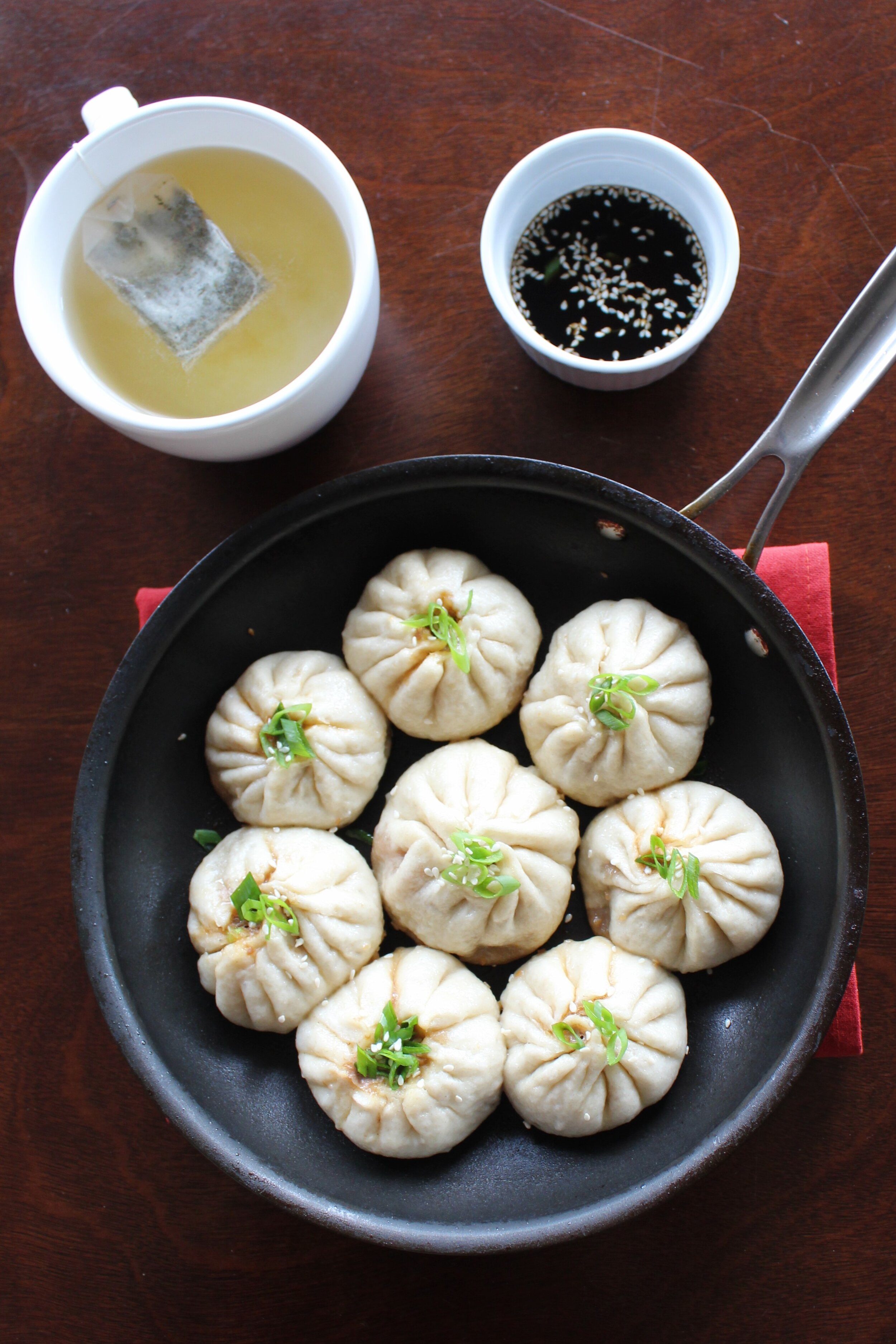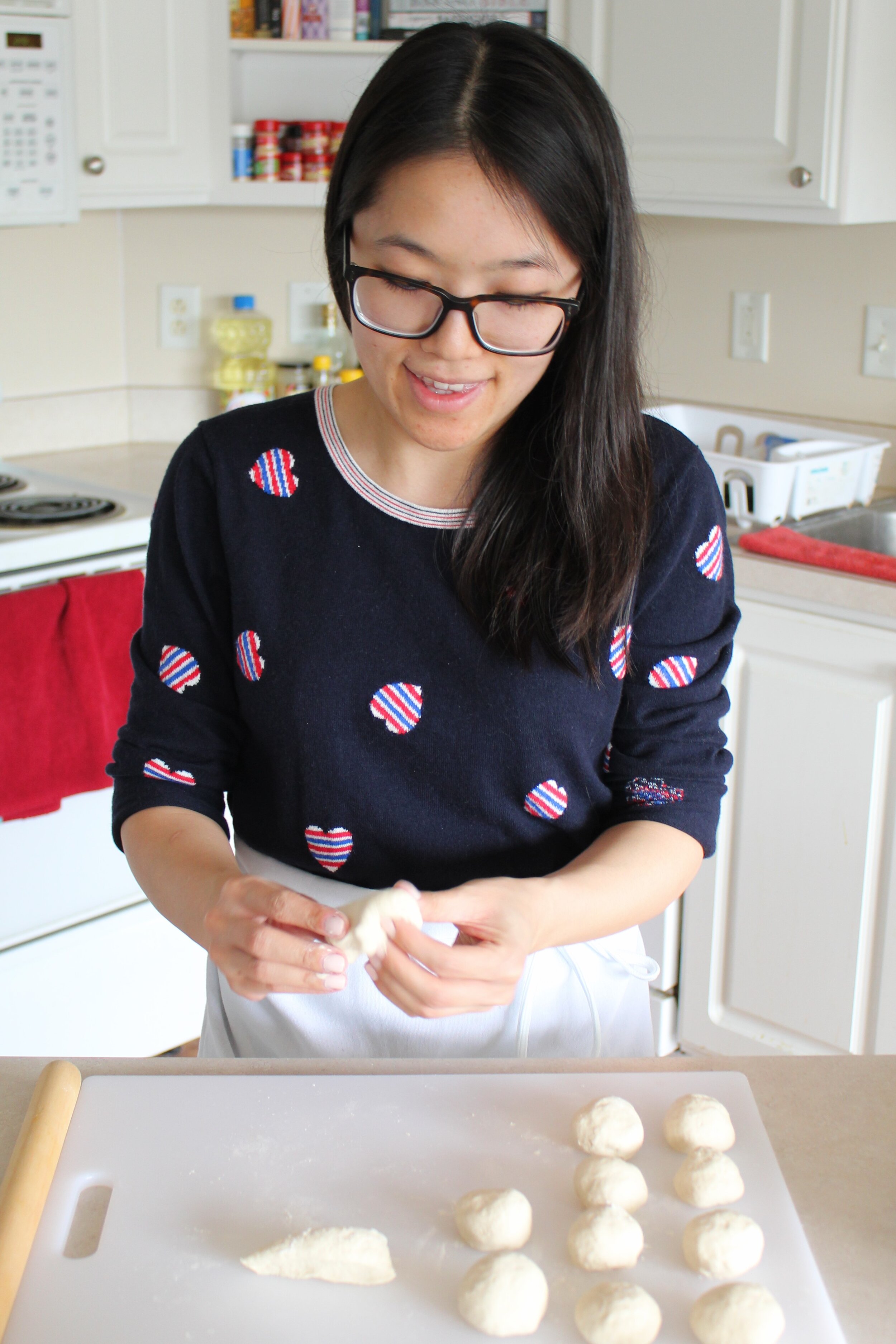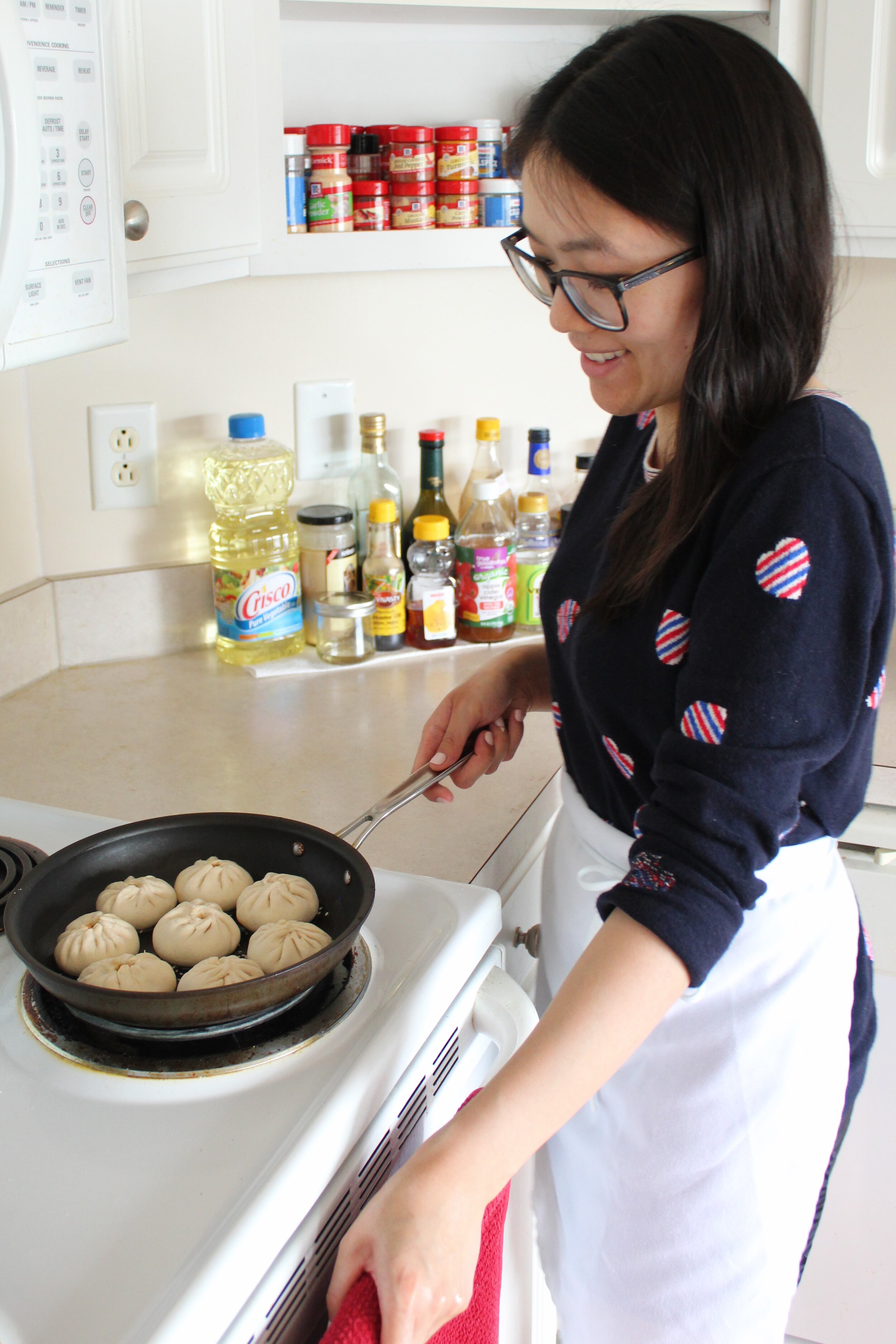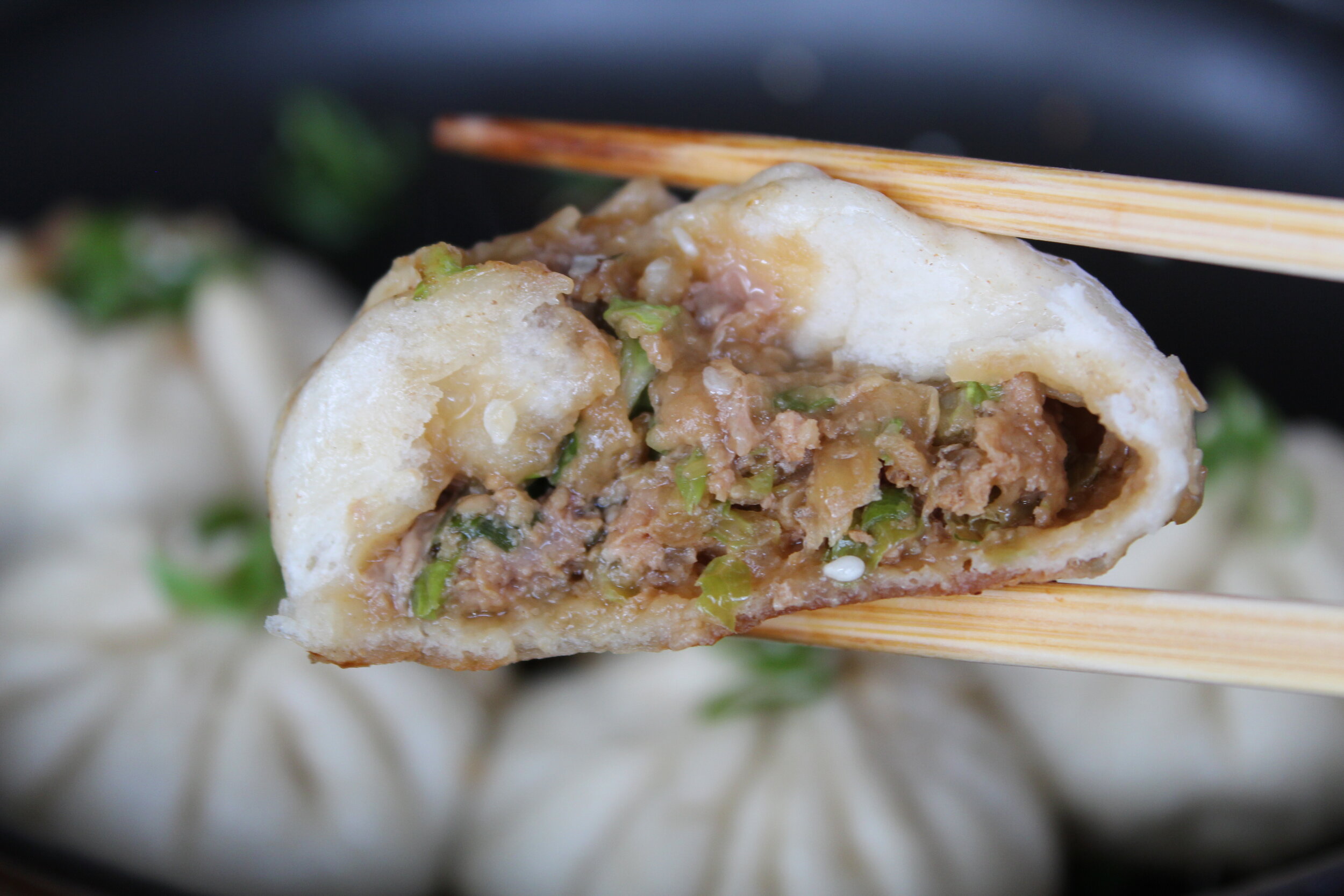May 18, 2020
I have been in full recipe development mode during the last two months. Businesses in Ohio are beginning to slowly open. Kevin and I have continued to stay indoors. On the weeks in between trips to the grocery store, I find myself scouring through my pantry to try to use up each and every ingredient I have on hand. These days, I try to limit the number of times I stop by the grocery store to replenish on ingredients. I used to stop by the grocery store once a week, but these last few weeks, I have only stopped by the grocery store once every 2-3 weeks. My cooking and baking frenzy have led me to finding new ways to put spins on old favorites and test out new ideas along the way. One dish I have been working on is a version of fried and steamed pork buns, a loose interpretation of Sheng Jian Bao. Sheng Jian Bao is a type of bun in Shanghai cuisine. It features a fluffy bun with a crispy bottom and is filled with meat and vegetables. I love it because it combines two of my favorite foods of all time – pork dumplings and steamed buns. I applied cooking techniques from making dumplings and steamed buns to create my fried and steamed pork buns. I fry the buns first in a skillet, then add water, and steam the buns. This is how I get the perfect crispy bottoms on my pork buns. The dough for the buns is almost the same as the one I use for my steamed buns. It did take me a couple tries to get the dough just right, but once I got the ratios for the dough down, I ended up with the most fluffy, crispy, and savory fried and steamed pork buns. Before I could share my pork buns, I needed to let Kevin taste them first. Kevin, my husband, grew up in Hong Kong and had his fair share of authentic Shanghai cuisine. Some of his best memories with his family involved sampling some of the best Shanghai food in the world. He is also brutally honest when it comes to giving feedback on the authenticity of my interpretations of his favorite foods. When Kevin and I both traveled to visit his family in Hong Kong earlier this year, we ate at some of the best restaurants specializing in Shanghai cuisine. Kevin always orders Xiao Long Bao and Shanghai noodles. I prefer scallion pancakes. Kevin’s family loves good food, so I know all of their restaurant recommendations are top notch. Back in our home in Ohio, I am constantly testing and retesting recipes to make sure I get them just right. Once I finished preparing my fried and steamed pork buns, I served them up to Kevin and he ended up eating ten buns. He did reserve just two buns for me, so I can at least taste my own creations. Watching him eat the fried and steamed pork buns with pure joy on his face meant my recipe was ready for sharing. Enjoy!
For the fried and steamed pork buns:
· 1-2 tablespoons of vegetable oil, for frying
· ¼-½ teaspoon sesame seeds (optional)
For the dough:
· 1 cup cake flour
· ½ teaspoon active dry yeast
· ½ teaspoon kosher salt
· ½ teaspoon granulated sugar
· ½ cup lukewarm water
· ½ cup all-purpose flour, plus additional ¼ cup for kneading the dough
For the filling:
· 2 cloves garlic, grated
· ½ inch knob of ginger, grated
· ½ pound ground pork
· 5-6 leaves Napa cabbage, finely chopped
· ½ teaspoon Shaoxing wine (optional)
· ½ teaspoon light soy sauce
· ½ teaspoon dark soy sauce
· ½ teaspoon sesame oil
· ½ teaspoon oyster sauce
· ½ teaspoon confectioners’ sugar
· ¼ teaspoon kosher salt
· Dash of white pepper
For steaming the buns:
· ¼ to ½ cup water
For garnishing:
· ½ teaspoon sesame seeds (optional)
· 1 stalk of scallion, thinly sliced (optional)
Directions:
1) Drizzle a tablespoon of vegetable oil in a skillet. Sprinkle in ¼ teaspoon of sesame seeds. Repeat as needed in another skillet Set aside.
2) To make the dough, combine the cake flour, active dry yeast, kosher salt, and sugar in a large bowl. Add the lukewarm water to the mixture. Use your hands to thoroughly mix the dough. The dough will be sticky at this point. Gradually add the ½ cup of all-purpose flour slowly into the bowl as you continue kneading the dough for about 3-5 minutes. Let the dough rest for 30 minutes to an hour. While the dough is resting, you can start making the filling.
3) To make the filling, combine the grated garlic, grated ginger, ground pork, chopped cabbage, Shaoxing wine (optional), soy sauces, sesame oil, oyster sauce, confectioners’ sugar, salt, and white pepper in a bowl. Use your hands to combine all ingredients until well mixed. Set aside.
4) When the resting time for the dough is up, turn the stovetop to medium high heat.
5) As the stovetop is heating, roll the dough out into a thick circle. Cut the dough in half horizontally. Then, in half again horizontally until you have four triangular pieces. Cut each of the triangular pieces into three equal pieces until you form twelve triangular pieces of dough. Roll each piece of dough into a circle. To make the buns, prepare a small bowl of flour using the ¼ cup of all-purpose flour. Sprinkle a small bit of flour onto a surface and begin rolling out the pieces of dough into a circle one by one onto a lightly floured surface. Place about one tablespoon of filling on each piece of dough. Bring the edges up, pleat and pinch around the edge of the dough wrapper until you form a rounded bun. Pinch the top of the bun to seal the dough leaving a small hole for steaming. Continue this process with the rest of the dough balls and filling.
6) Arrange the buns in the skillet filled with the tablespoon of oil and sprinkle of sesame seeds leaving some space between each of the buns. Repeat as needed in another skillet.
7) Place the skillet on the heated stovetop. Let the bottoms of the buns crisp up, about 3-5 minutes. Pour in ¼ cup of water into the skillet. Repeat as needed in another skillet. Let the buns steam until the water evaporates and continue to let the buns cook in the heated skillet, about 8-10 minutes. The fried and steamed buns will be very hot at this point. Let the buns rest for 5 minutes before serving. If garnishing, top the buns with a sprinkle of sesame seeds and sliced scallions.
Takeaways: The recipe yields about twelve buns depending on how small or large you cut your dough pieces. The fried and steamed pork buns are perfect on their own, but Kevin prefers to serve them with a blend of Chinkiang vinegar and soy sauce. If you have leftover filling, you can brown the filling and toss them into some whisked eggs to make omelets. For a vegetable version, try the filling for my rainbow veggie dumplings or veggie steamed buns.























